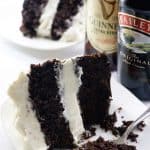Guinness Chocolate Cake with Baileys Cream Cheese Frosting
Guinness stout adds a deep, rich flavor to this chocolate cake and combines perfectly with the Baileys cream cheese frosting
Servings: 12 servings
Ingredients
- 1 (12 ounces) bottle of Guinness stout
- 1 cup unsweetened cocoa powder (80 grams)
- 2 cups sugar (400 grams)
- 1-¾ cup all-purpose flour (210 grams)
- 2 tsp baking powder
- 1-½ tsp baking soda
- 1 tsp salt
- 1 cup sour cream (225 grams)
- ½ cup oil (100 grams)
- 2 eggs
- 2 tsp vanilla extract
BAILEYS CREAM CHEESE FROSTING
- 16 ounces cream cheese softened
- 3 cups powdered sugar, sifted (372 grams)
- 1 tablespoon cornstarch
- 3 to 4 tablespoons Baileys Irish Cream
- 1-¼ cups heavy cream
Instructions
- Preheat the oven to 350°. Line the bottom of two 9-inch cake pans with parchment paper, grease, and flour the sides. (The parchment paper will make the cake come out much easier).
- Pour the Guinness stout into a medium saucepan and bring to a simmer over medium heat. Simmer for 8 to 10 minutes or until it has reduced to 1 cup. Reducing the Guinness will give the cake a richer, more intense flavor,
- Remove the Guinness stout from the heat and whisk the cocoa powder until smooth. Set aside to cool (it should cool enough that you can comfortably touch it).
- In a large mixing bowl, add the sugar, flour, baking powder, baking soda, and salt. Using a whisk, blend and sift the ingredients together.
- Add the sour cream, oil, eggs, vanilla, and the cocoa mixture to the dry ingredients. Mix on low speed for 30 seconds until the dry ingredients are moist. Increase the speed to medium and beat for 1 minute. Scrape down the sides and beat for another minute.
- Pour the batter into the two prepared pans and place in the center of the preheated oven. Bake for 30 to 35 minutes (a toothpick inserted in the center of the cakes should come out clean or with just a few crumbs).
- Let the cakes cool in the pans for 5 to 10 minutes, then run a knife around the edge of the pans to loosen the cake. Invert the cakes onto a cooling rack and remove the parchment paper. (At this point if you re-invert the cakes onto another rack and let them cool with their tops up, they will retain more height and the tops of the cakes will not stick to the cooling rack.)
Baileys Cream Cheese Frosting:
- To make the frosting, beat the cream cheese until soft then add the powdered sugar, cornstarch, and Baileys Irish Cream. Beat until creamy and smooth.
- In a separate bowl, whip the heavy cream on high speed until stiff peaks form. Use a wide spatula to fold the whipped cream into the cream cheese mixture.
Assemble the cake:
- Put a dab of frosting on a cake plate and place a cake layer on top of the plate. Spread or pipe half of the frosting on top of the cake layer. Place the second cake layer on top of the frosting. Spread or pipe the rest of the frosting on top of the cake.
Notes
- Store the cake in the fridge.
- Here is a tip to make it easier to frost the cake: Partially freeze the cake layers for approximately 20 minutes before frosting. After keeping it in the freezer for a short time, the partially frozen cake will be firmer and easier to frost.
- Try to find heavy cream for the frosting. Heavy cream has more butterfat than whipping cream and will make a more stable frosting. When I used cream with 40% butterfat I was able to put 4 tablespoons of Bailey's Irish Cream into the frosting. When I trialed this recipe with 30% butterfat whipping cream, the frosting only held 3 tablespoons of Bailey's. More than that and the frosting was a bit too "loose" but still delicious.
Nutrition
Serving: 1 | Calories: 711kcal | Carbohydrates: 86g | Protein: 8g | Fat: 37g | Saturated Fat: 16g | Polyunsaturated Fat: 16g | Trans Fat: 1g | Cholesterol: 109mg | Sodium: 578mg | Fiber: 2g | Sugar: 65g
